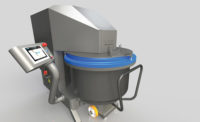Implementing stringent equipment maintenance and sanitation programs in their facilities will enable bakers and snack producers to better comply with the Food Safety Modernization Act. New and improved equipment and supplies make the job easier.
Most bakers and snack manufacturers have always followed stringent equipment maintenance and sanitation practices to ensure that their goods are safe and to avoid product recalls. For these companies, the Food Safety Modernization Act (FSMA) means taking existing practices to the next level by standardizing them and creating an official program.
“In the past, many companies identified their [cleaning and maintenance] practices, but may not have standardized them,” says Kevin Lemen, vice president, sales and marketing at Douglas Machines Corp., Clearwater, Fla. “Now, they are developing, implementing and tracking standard operating procedures to ensure an effective food-safety program. The use of automated equipment has always produced labor, water and energy savings, but now it has added value in producing consistent, repeatable results that can be documented.”
Douglas Machines, he says, has more than 80 industrial washer models to clean everything from pans and racks to belts and parts. Its batch and continuous-cleaning systems can clean several hundred to several thousand containers an hour.
Like other manufacturers of equipment for the baking industry, Douglas Machines continues to improve its washing systems to make sanitation and maintenance easier, more effective and more cost-effective for users. Says Lemen, “We have implemented sloped roofs that don’t pool water, tube versus angle framing that doesn’t collect debris and enhanced access to hard-to-clean areas.”
Step in the right direction
Keeping food-processing equipment, including pans and parts, clean is just one part of the sanitation and maintenance equation. Bakers and snack manufacturers also have to make sure that workers aren’t accidentally bringing contaminants onto the production floor. One place to start is at the bottom, with employees’ footwear.
“A dedicated boot program is a good place to begin,” says April Zeman, national account manager, of Best Sanitizers Inc., Penn Valley, Calif. The company offers a variety of industrial sanitation products. Each employee should have a set of footwear that resides at the plant, and a program for cleaning and sanitizing the footwear before and after each shift.
Some of the most common methods of footwear cleaning and sanitation include boot baths and boot-washing stations and/or a foaming floor sanitizer at entrances, both of which typically use chlorine or quat-based (quaternary ammonium) sanitizers diluted in water. With footbaths and foaming entrance systems, constant monitoring is needed to ensure the level of diluted sanitizer does not fall below effective levels.
Boot-washing stations mechanically remove debris from boots while applying diluted chlorine or quat-based sanitizers to them. Zeman says that while these systems provide an effective method for cleaning boots, it’s still important to monitor debris and bacteria retention.
Best Sanitizers’ HACCP (hazard analysis critical control point) Defender low-moisture, walk-through, automatic, boot-sanitizing station uses fresh sanitizer with each application for a greater and more consistent log reduction of pathogens on footwear, while eliminating the labor associated with footbaths and foaming stations.
Dry sanitation
One way to improve an equipment sanitation program is to identify areas on equipment where using a sanitizer intended for use in dry environments would be more effective than a water-based sanitizer, Zeman says. She cites motors, control panels, proximity switches, electrical panels and thermostats as examples. Alcohol-based products, for instance, dry rapidly and are ideal for sanitizing water-sensitive equipment. They also help minimize additional moisture in a moisture-sensitive environments.
Zeman says when considering a sanitizer, bakers and snack producers should verify that the product is safe to use in food-processing areas, verify its legal registration documentation with the appropriate approving agencies and confirm that it’s non-
corrosive and kosher- and pareve-certified, as appropriate.
Sanitizing wipes, in addition to meeting all of the attributes above, must be safe for food-contact surfaces and be lint-free. Best Sanitizers’ ready-to-use Alpet D2 Surface Sanitizing Wipes are no-rinse, food-contact-surface safe and lintless.
Dry sanitation programs not only can reduce equipment damage and production downtime, they can help bakers and snack producers meet their sustainability goals.
“One of the biggest challenges facing manufacturers today is sanitizing, while at the same time controlling water use and wastewater levels,” says Werner Diercks, CEO, AmeriVap Systems Inc., Dawsonville, Ga., which makes industrial and commercial dry-steam-vapor cleaning systems. “This is particularly true on the West Coast, especially in light of the region’s severe drought. It is not entirely an issue of saving money, but also of hitting sustainability targets.”
AmeriVap has two new pieces of cleaning equipment designed to meet bakers’ and snack manufacturers’ needs: The TruBlu Steam generator; and the Houdini Magic Box. According to the company, the TruBlu delivers hotter, drier steam than its regular Xtreme Steam models—at temperatures up to 500 deg. F internally and approximately 320 deg. F at the point of contact, with 1% moisture. “It achieves an incredibly low moisture level of dry steam for cleaning,” says Diercks. “It’s the only generator of its kind on the market.”
The Houdini Magic Box, an automatic conveyor belt-cleaning attachment for the company’s Xtreme Steam generators, cleans, sanitizes and vacuums interlocking and mesh conveyor belts using only dry steam and no chemicals.
“One way manufacturers can improve sanitation, as well as hit sustainability targets and control budgets, is to incorporate the use of dry steam in their sanitation programs,” says Diercks. “It uses a fraction of the water of conventional methods, like pressure washing. It can penetrate hard-to-reach nooks and crannies that could harbor harmful bacteria. Finally, dry steam is easy to use.”
Food-safe lubricants
Effective equipment sanitation and maintenance programs aren’t just about removing potentially harmful things from food-processing equipment, they’re also about putting the right chemicals on machinery to keep it operating properly and not impact the finished product.
“The FSMA has placed a higher importance on the risk analysis done by a bakery, snack or other food manufacturer in regard to the chemicals being used around the end product,” says Toby Porter, food market manager, Klüber Lubrication North America L.P., Londonderry, N.H.
“This includes sanitation where cleaning procedures are in place for various pieces of equipment that come in contact with or are in the food processing and packaging environment. The review of these procedures has led to an increase in demand for a lubricant and/or cleaning agent that isn’t just safe for incidental contact, but is manufactured with these new higher safety standards in mind. The [NSF International] ISO 21469 standard is meant for this purpose.”
The ISO 21469 certification program specifies hygiene requirements for the formulation, manufacturing, handling and use of specific lubricants and evaluates the risks associated with using them at manufacturing facilities.
Klüber Lubrication offers a variety of specialty lubricants for the food-processing industry that comply with food regulations. The products have no smell or taste and are certified according to all pertinent laws and regulations.
Adam Bzowski, North American sales manager, Chain Guard Industrial Lubricants, says that prior to the FSMA, “many industrial/wholesale bakeries took steps to use registered food-grade lubricants on their oven chains and other equipment requiring lubrication. These changes have often been implemented organically; at other times, socially-conscious changes toward food-grade lubricants are a result of requests from the bakery’s customer base.”
The Markham, Ontario-based company specializes in lubricating products designed specifically for the food-processing industry, including high-temperature, synthetic, food-grade greases and lubricants. Its Formula 600 High Temperature Food Grade Spray Lubricant, which is designed for general lubricating use and in maintenance departments, gives bakeries one product that’s usable at high temperatures and is food-grade. Its CG-FS-PC-100-H1 Food Grade Proofer Chain-High Humidity Environment Lubricant is a food-grade, white, oil-based, chain oil, specifically designed to perform in high-humidity environments. It’s designed not to emulsify with water, thus reducing metal-to-metal friction and protecting against rust.
When asked how bakers and snack manufacturers can improve their sanitation programs, Porter says, “In addition to the risk-analysis review requirements under FSMA done at the plant, [they] can improve an equipment sanitation program by ensuring that all lubricants being used for individual components carry the same high standard in regard to safety. For a lubricant, the ISO 21469 certification, in addition to the NSF H1 registration, provides this higher standard.”
Being aware of the safety of all different cleaning agents being used around machinery is critical, too. “These chemicals could also potentially come in contact with a food product,” he says.
Bakers and snack manufacturers that already have proper sanitation and maintenance programs in place know they are worth the effort. “One of the benefits that come from utilizing proper sanitation procedures is an increase in sustainability,” says Porter. “Contaminants, whether it’s in food or in the lubrication of machinery, can lead to increased costs very quickly, either through recalls or unplanned maintenance. A well-designed sanitation and lubrication program can help to decrease the overall costs associated with the production of baking, snack and food products in general.”








